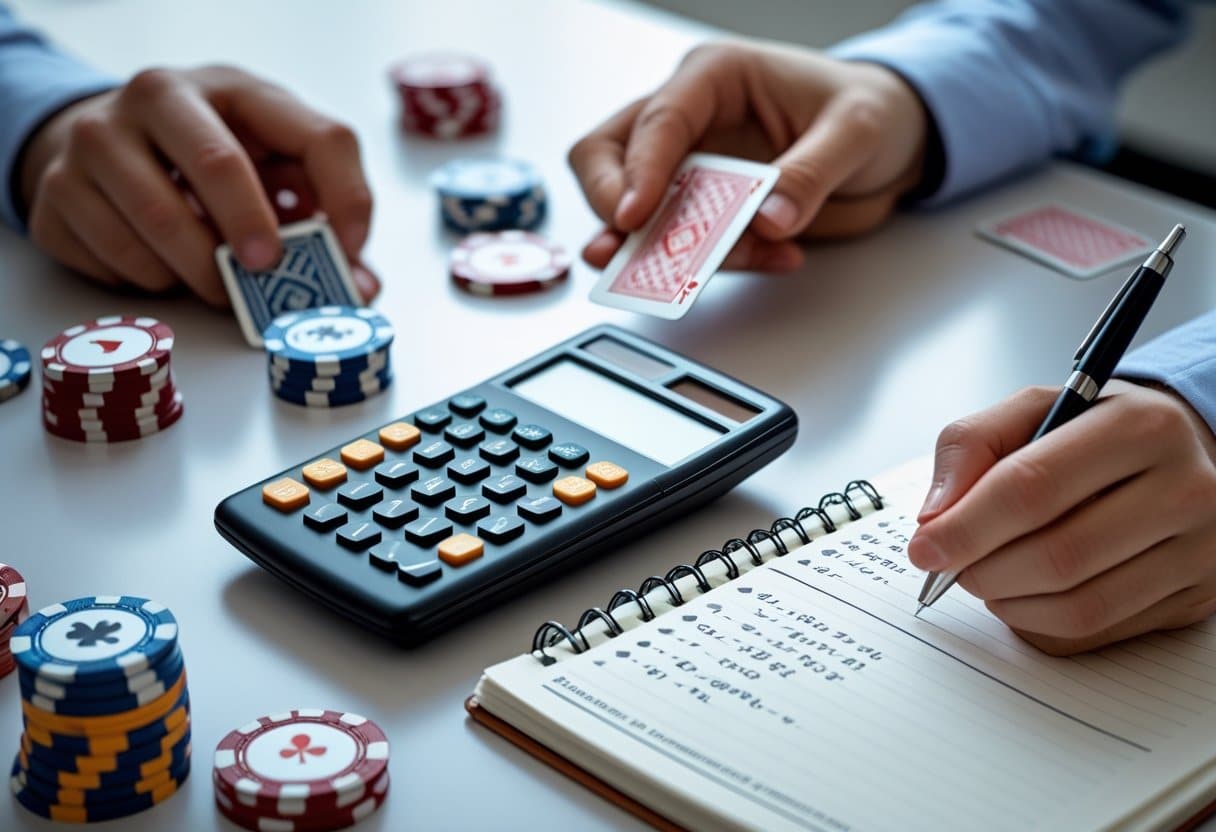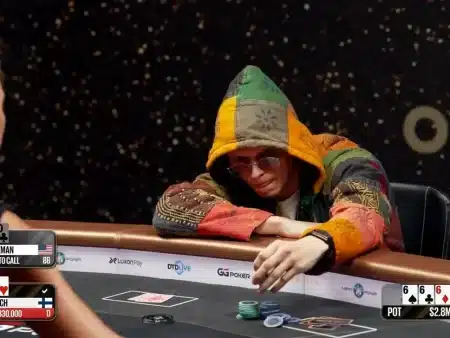Poker isn’t just about reading faces or pulling off a perfect bluff. The math behind the game? It’s actually not as scary as people think.
A lot of players avoid poker math, assuming it’s reserved for geniuses or math majors. But honestly, the basics are pretty approachable if you’re willing to give it a shot.

Simple arithmetic at the table can give you a real edge and help you win more often. If you can get comfortable with pot odds, counting outs, and the rule of 2 and 4, you’ll have the foundation for solid, profitable play.
These little calculations help you figure out when to call, fold, or raise, and most of the time, they’re straightforward once you see them in action.
You don’t need a PhD to use poker math well. The core ideas are pretty easy to pick up, especially if you focus on No Limit Hold’em.
Once the basics are second nature, you can shift your attention to reading people and making moves, knowing the math’s got your back.
Core Poker Math Fundamentals

Poker math is at the heart of smart play. If you want to make decisions based on facts instead of just a hunch, these concepts are worth knowing.
Understanding Odds and Probabilities
Poker odds show how likely you are to hit a drawing hand. Usually, they’re written as ratios, like 4:1—so you’ll miss four times for every time you hit.
To figure out your odds, start by counting your “outs”—the cards that can make your hand better. Say you’re chasing a flush and there are 9 hearts left; that’s 9 outs.
The “Rule of 4 and 2” is a quick shortcut. Multiply your outs by 4 on the flop for your chance to hit by the river. Multiply by 2 when you’re on the turn.
So with 9 outs on the flop, you’ve got about a 36% shot (9 × 4) to hit your flush by the river.
Percentages in Poker Calculations
Switching odds to percentages just makes life easier at the table. To convert, use: Probability (%) = 100 ÷ (Odds + 1).
Pot odds are about what you might win versus what you have to bet. If the pot’s $100 and you need to call $20, those are 5:1 odds ($100:$20).
Expected Value (EV) is the long-term profit or loss from a play:
- Positive EV (+EV): you’ll make money, eventually
- Negative EV (-EV): you’ll lose in the long run
For example, risking $20 to win $100 with a 25% chance gives you an EV of +$5. That’s a good call, even if it feels risky.
Basic Poker Hand Combinations
Knowing hand combinations helps you size up your own hand and guess what others might hold.
There are 1,326 possible starting hands in Texas Hold’em (52 × 51 ÷ 2). Kind of wild, right?
Pocket pairs don’t come around often:
- 6 combos for each pocket pair (AA, KK, etc.)
- 16 combos for each suited hand (A♥K♥, A♠K♠, etc.)
- 12 combos for each unsuited hand (A♥K♠, A♣K♦, etc.)
A few pre-flop stats to keep in your back pocket:
- Dealt AA: 0.45% of the time (about once every 221 hands)
- Any pocket pair: 5.9%
- Suited cards: 23.5%
All this stuff lays the groundwork for range analysis and reading hands.
Calculating Outs and Drawing Hands
Being able to count your “outs” is essential if you want to make smart calls (or folds) when you’re on a draw. It’s not rocket science, but it does give you a real edge.
Counting Outs for Common Scenarios
An “out” is just any card that’ll likely make your hand a winner. First, figure out what you need—then count how many cards would get you there.
Common Drawing Hand Outs:
- Flush Draw: 9 outs (13 in suit minus the 4 you see)
- Open-Ended Straight Draw: 8 outs (4 cards at each end)
- Inside Straight Draw: 4 outs (only the ones that fill the gap)
- Two Overcards: 6 outs (three of each overcard)
- Pair to Set: 2 outs (the other two of your pair)
To estimate your shot at hitting on the next card, just use the “Rule of 2 and 4.” Multiply outs by 2 for one card (turn), or 4 for both turn and river.
Flush and Straight Draw Probabilities
Flush and straight draws come up all the time, so it’s handy to know their odds.
Flush Draw Odds:
- 4 cards to a flush after the flop
- 9 outs left in the deck
- About 19% to hit on the turn (9 × 2)
- Roughly 35% to hit by the river (9 × 4)
Straight Draw Comparison:
| Draw Type | Outs | Turn % | River % |
|---|---|---|---|
| Open-Ended | 8 | ~16% | ~32% |
| Inside (Gutshot) | 4 | ~8% | ~16% |
Pot odds need to be better than these percentages to make a call worth it. So, if you’re on a flush draw, you want better than 2:1 odds to call after the flop.
Special Draws: Nut Flush, Open-Ended, and Inside Straights
Not all draws are made equal—sometimes even hitting your draw isn’t enough.
A nut flush draw means you’ll have the best possible flush if you hit. That’s way safer than chasing a low flush that could get beat.
Open-ended straight draws (8 outs) are a lot better than inside straight draws (4 outs). With 7-8-9-10, either a 6 or Jack completes your straight.
Combo draws are even better—like having both a flush and straight draw at once. Sometimes that means 15 outs (9 + 8, minus overlap).
For a quick percentage: divide outs by unseen cards and multiply by 100. But honestly, doubling your outs (and adding one if you’ve got more than 8 outs) is usually close enough.
Essential Odds Calculations in Poker
Knowing your odds helps you avoid wild guesses and make smarter bets. It’s about using math, not just vibes.
Hand Odds and Pot Odds Explained
Hand odds are your chances of making your draw. Start by counting your “outs”—say, 9 for a flush draw. That’s about 4-to-1 on the flop.
The “Rule of 4 and 2” is your friend: multiply outs by 4 on the flop for your shot by the river, or by 2 on the turn.
Pot odds compare what you could win to what you have to call. If the pot’s $100 and you need to call $20, those are 5-to-1 odds.
Key Decision Point: If your hand odds are better than the pot odds, it’s a call. If pot odds are worse, folding is usually right.
Betting Odds and Betting Percentages
Betting odds can be flipped into percentages, which make things easier. For example, 3-to-1 odds means a 25% chance (1 ÷ 4 = 0.25).
This comes in handy for figuring out pot equity—your share of the pot, mathematically speaking. With 25% equity, you “own” a quarter of the pot.
Common Betting Percentages:
- 50% chance = even money (1-to-1)
- 33% chance = 2-to-1 odds
- 20% chance = 4-to-1 odds
Implied odds are kind of the secret sauce—they include future bets you might win if you hit your draw.
When you’re facing a bet, divide what you need to call by the total pot (after calling) to get the break-even percentage. If your chance to win is higher than that, you’re making a profitable call.
Equity and Expected Value for Poker Decisions
Poker decisions boil down to equity and expected value. These numbers help you ditch the guesswork and make choices that’ll pay off over time.
Calculating Pot Equity
Pot equity is your shot at winning if everyone goes to showdown. Count your “outs”—the cards that’ll make your hand.
Quick math: use the “Rule of 2 and 4.”
- Flop: Outs × 4 = %
- Turn: Outs × 2 = %
If you’re on a flush draw with 9 outs after the flop, you’ve got about 36% equity (9 × 4).
For more accuracy, you’ll need to think about:
- Your current hand strength
- Possible improvements
- What your opponent might have
There are calculators online if you want to get nerdy, but knowing the basics is a big help at the table.
Expected Value in Poker Situations
Expected Value (EV) is all about the long run. A positive EV means you’ll profit over time—even if you lose this particular hand.
To figure out EV for a bet:
- Find your chance to win
- Multiply your winnings by that chance
- Multiply your losses by the chance you lose
- Add it all up
Example: betting $10 with a 40% shot at $25. EV = (0.4 × $25) – (0.6 × $10) = $10 – $6 = $4.
Positive EV (+$4) means it’s a good call, even if you’ll lose more often than win.
Good players focus on EV, not just the results of one hand. Sometimes you get unlucky, but if you keep making +EV decisions, the profits eventually show up.
Practical Poker Math Applications
Poker math isn’t just theory—it’s super useful in real games. Folding when the odds aren’t right and using quick-reference charts can really sharpen your game.
Making Better Fold Decisions
Knowing when to fold is underrated, honestly. Pot odds can tell you when it’s time to let a hand go.
Say the pot’s $100 and you need to call $25. That’s 4:1 odds.
If your chance to hit your hand is worse than the pot odds, folding is the right play. Like, if you’re on a flush draw with four suited cards, you’ve got about a 1 in 5 chance to hit on the next card.
If the pot isn’t giving you at least 4:1 odds, folding is the smarter move. Lots of players lose money chasing draws when the math says otherwise.
Percentage Charts and Quick References
A lot of successful players swear by memorizing those key percentage charts—they’re honestly a lifesaver when you need to make a snap decision at the table. Charts like these break down the odds for hitting hands like flushes (which, after the flop, land about 19.1% of the time) or full houses (if you’re holding a pair, it’s roughly 16.7%).
Having these numbers in your back pocket? That does two big things:
- Speed: You simply can’t sit there crunching numbers forever.
- Accuracy: It’s way too easy to let nerves or excitement cloud your judgment, but the math doesn’t lie.
Even something as basic as knowing pocket pairs will hit a set on the flop only about 12% of the time—that can totally shape how you bet. Some folks even keep tiny reference cards tucked away, just to glance at between hands.
The real pros? They don’t even seem to think about the math anymore. It’s like the odds are second nature, so they can actually pay attention to what their opponents are up to, all while making solid decisions.













